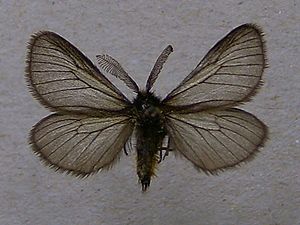Blackbird
| Blackbird | ||||||||||||
|---|---|---|---|---|---|---|---|---|---|---|---|---|

Black moth ( Penthophera morio ), ♂ |
||||||||||||
| Systematics | ||||||||||||
|
||||||||||||
| Scientific name | ||||||||||||
| Penthophera morio | ||||||||||||
| ( Linnaeus , 1767) |
The black moth ( Penthophera morio ) is a butterfly ( moth ) from the subfamily of the bearer moth (Lymantriinae) within the family of the owl butterflies (Noctuidae).
features
Imago
The male moths reach a wingspan of 22 to 32 millimeters. There is a strong sexual dimorphism between the two sexes . The males have normally developed wings, which are mostly black, more rarely brownish and finely hairy on the outer edges. The veins are clearly visible, the scales are thin. As a result, the wings sometimes look like parchment. The antennae are long, double combed.
The females have almost completely regressed stub wings, are unable to fly and have a plump body that does not correspond to that of a typical butterfly. Their bodies have short hairs and are gray-yellow or gray-brown in color. The thorax and abdomen are much larger than those of the males. The antennae have very short comb teeth.
Caterpillar
The caterpillar has a black basic color with yellow, interrupted vertical stripes. It has red and yellow button warts with gray hair. The female caterpillar is much larger than the male.
Doll
The pupa is yellowish, has brown markings and is hairy white-gray.
Synonyms
Its synonym is Hypogymna morio .
Occurrence
The species occurs in south-eastern Central Europe . In Burgenland , Lower Austria and Hungary , it is common in very limited places. She prefers open meadow landscapes. The species was also found further west, for example in Vorarlberg .
Way of life
The male moths are diurnal and fly over meadows in search of the females. After the female emerges from its cocoon , it secretes pheromones to attract the males. After mating, the female lays her eggs on stalks. The caterpillars overwinter. They pupate in a thin, tissue-like cocoon.
Flight and caterpillar times
Most of the moths fly in one generation from April to June. Under favorable conditions, a second generation occurs in areas in July and August. The majority of the caterpillars can be found from June and after wintering until April of the following year.
Food of the caterpillars
The caterpillars feed on the stalks of various types of grass of the genus ( Lolilium ).
swell
literature
- Walter Forster , Theodor A. Wohlfahrt : The butterflies of Central Europe. Volume 3: Weirdos and Swarmers. (Bombyces and Sphinges). Franckh'sche Verlagshandlung, Stuttgart 1960, DNB 456642196 .
Individual evidence
- ↑ a b c d Walter Forster, Theodor A. Wohlfahrt: The butterflies of Central Europe. Volume 3: Weirdos and Swarmers. (Bombyces and Sphinges). Franckh'sche Verlagshandlung, Stuttgart 1960, DNB 456642196 .
- ↑ Hypogymna morio L. - An isolated occurrence in Vorarlberg In: Journal of the Vienna Entomological Society, 29th year (PDF; 536 kB)
Web links
- http://www.lepiforum.de Taxonomy and photos
- www.leps.it photos
- http://www.funet.fi distribution
- Penthophera morio at Fauna Europaea. Retrieved May 2, 2011